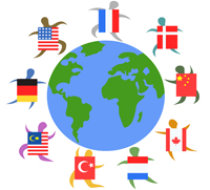Russian multiculturalism in the media: the technique of content analysis of the news
On March 15 Alena A. Khaptsova (Junior Research Fellow of International laboratory for Socio-Cultural Research, lecturer of School of Psychology, Faculty of Social Sciences, HSE) took part in the ô¨Culture mattersô£ research seminar with the report on "Russian multiculturalism in the media: the technique of content analysis of the news".
The report presents the technique cotnent-analysis of news developed by the staff of International laboratory for Socio-Cultural Research Alena Khaptsova, Maria Klyass and Bogdan Chuprikov. This method is intended for identifying markers of multiculturalism in the Russian media. The technique is the scheme for deductive content analysis. During the development of technique the literature on multiculturalism and inter-ethnic relations was analyzed. On the basis of theoretical analysis the groups of markers of multiculturalism in the news media were formed. The scheme allows to fix multiculturalism in the news.
According to POF (2014) the Russians spend about 3 hours on TV every day, while most people believe that Russian TV is objective and credible. Taking into consideration that most information about the world which available to the modern man inaccessible to direct observation, it is important to study what kind of information people receive through the media. The relevance of the study of world representation in the media especially important when it comes to inter-ethnic relations and attitudes toward out-groups.
According to of J. Berryãs theory, prosperous coexistence of different ethnic groups is possible under the following conditions:
- confidence in their own identity, which leads to mutual respect among members of different ethnic groups and reduction of discrimination;
- participation and involvement of representatives of different ethnic groups in the life of ethnic communities, and in society in general, providing people with the necessary social capital for a prosperous life;
- contact between representatives of different ethnic groups, which leads to mutual acceptance of groups;
- presence of a common identity for members of different ethnic groups (identity with the country, Russia).
For these conditions there are various state programs. Multiculturalism is paid much attention in education either. People's attitude to multiculturalism has been actively studied in Moscow and in the North Caucasus. However, do the media show these efforts?
The report shows the results of the analysis of TV and on-line news for the 8-week period. For example, it was found that television (the program "Time" First channel; and the program Vesti channel Russia-1) displays sense of belonging to Russia ("We are Russians!") and ethnic diversity as a guarantee of positive inter-ethnic relations in Russia. In turn, the Internet-editions (RIA Novosti and RBC) likely to hold rather pessimistic mood, talking about business relations between representatives of different cultures in Russia.
Also during the discussion of the report were discussed the ways of further use of the developed technique.
Maria Klyass
Research Intern
Alena Alexandrovna Khaptsova
Junior Research Fellow
Bogdan Chuprikov
Research Intern

